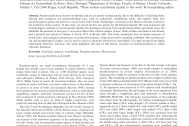Obsah
Pseudoscorpions are known worldwide and yet are poorly studied mainly due to the difficulty of detecting them. Among their predators are ground-dwelling taxa, such as arthropods, amphibians, birds, and reptiles. Only four pseudoscorpion species are known to occur in the Cabo Verde Archipelago, and none in the Desertas Islands, located in the northwest of the country. In this study, we record the first two species for the Desertas Islands. We used molecular and morphological methods to taxonomically identify the specimens retrieved from reptile faecal pellets and pitfall traps. We identified the presence of Garypus cf. saxicola on Raso Islet, Olpium pallipes (Lucas, 1849) on Raso and Santa Luzia Island, and a putative new species of Olpium L. Koch, 1873 on Branco Islet. This study emphasizes how an indirect measure of biodiversity and ecological interactions via potential predators, using non-invasive sampling combined with metabarcoding and morphological studies, can be used to uncover unknown biodiversity, particularly of cryptic groups from highly inaccessible locations. Likewise, this study highlights the lack of 16S genetic resources for pseudoscorpions in online reference databases.



